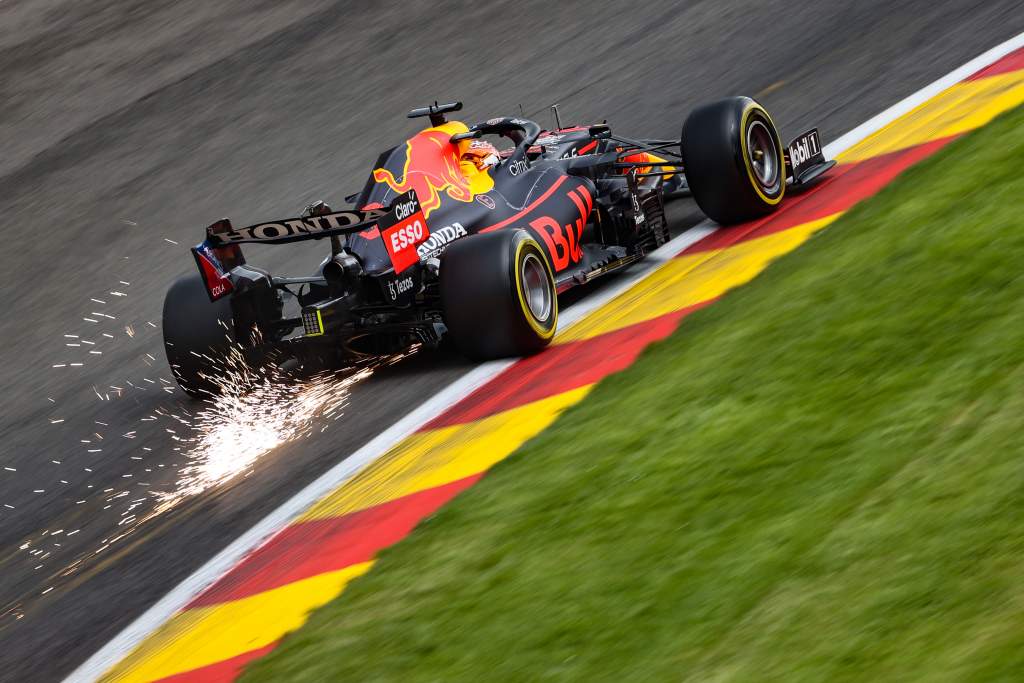Up Next

Honda’s new energy store it has recently introduced is its first battery technology upgrade since the initial hybrid Formula 1 engine it designed for 2015.
As revealed ahead of this weekend’s Russian Grand Prix, Honda has been using a new specification of energy store – F1’s terminology for the lithium-ion battery used within the hybrid system – since the summer break after starting the season with the same component it used in 2020.
Honda says the new battery provides improved power unit performance. The battery can provide unlimited energy to the MGU-H, which powers the turbocharger, and 4MJ per lap to the MGU-K, which deploys a maximum of 120kW of power to the engine.
The upgrade has improved the battery’s efficiency and durability, which should ensure the hybrid system can maximise its permitted energy deployment and not run out at the end of a lap, while the battery will suffer less cell deterioration through the season.
The new battery also has a “significant” reduction in weight. As the battery has a minimum weight of 20kg this means the previous version was overweight.

This is a significant step for Honda’s power unit because the battery technology has not been changed since 2015, only elements like the casing as the dimensions of the Honda engine evolved over the years.
Honda F1 technical director Toyoharu Tanabe described this as “chemical development”.
“There were some updates in the past,” Tanabe told The Race.
“But the cell itself, the material, continues from 2015 the same, and then now it’s completely new.
“One of the reasons is we don’t have enough experience or technology to develop the cell by ourselves.
“But we collaborated with Honda mass production R&D, they have a key project to improve to develop the battery, and then we bring that latest battery cell technology into the Formula 1 side as a pilot case.
“Now we can introduce that new one developed by Honda, trackside.”
The project, billed as the final major development item for Honda in F1, was led by Honda’s racing development facility in the UK, comprising more than 10 different nationalities, and had the full support of Honda’s Innovation Research Excellence research-and-development division and the road car battery development team from Honda’s automotive centre.

The long lead time of the battery meant it was not ready until the Belgian Grand Prix at the end of August.
“The technology of that battery area is, compared to the ICE, quite new and then we need to choose [how to use it],” Tanabe said.
“We need to consider the Formula 1 usage environment very much. So high stress, high G, temperature, everything.
“It’s mainly a material development, also the evaluation time is long. Once you fix the specification, then we do evaluation for durability, degradation.
“Also once we create the package cell we need to have a high G test for the safety. Also electric durability, how do we have durability [over the season]?
“That’s why the energy store development takes a long time.”
Honda originally intended for the new battery to be introduced as part of a brand new power unit for 2022, but that timeline was created before Honda’s decision to withdraw from F1 at the end of 2021.
That prompted the company to take on the ambitious aim of developing the all-new power unit for 2021 instead, its final year as an active manufacturer and major revisions to the internal combustion engine and reworked hybrid components were ready for the start of 2021.
Even though the new battery would be delayed, Honda felt it essential that it runs – partly so it could be used under the Honda name, but also so it could understand and improve any issues before Red Bull takes on the use of the engines from 2022.
If Honda did not give Red Bull and AlphaTauri the new battery until next year, Tanabe said: “If you have trouble or something, or to optimise the energy management, it may be difficult, especially if we have any issues there. Honda could not help directly.
“So, it’s good for us to introduce now and then get the experience – and improve our performance in this part [of the season] given the competitiveness between the top teams.
“There are two benefits for us.”







